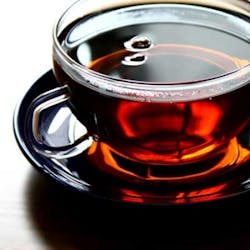Anxiety reduction in the office
By Maria Perno Goldie, RDH, MS
April 15 is Income Tax Day. Don’t forget to pay your taxes!Many people can have some anxiety about going to the dental office, but for individuals with true dental phobia, a dental visit can be horrifying These clients may be so frightened that they will take any measure to avoid a dental appointment, including not showing for the appointment or cancelling. Dental anxiety has been studied since the 1960s. All procedures in a dental office are potentially stress inducing.(1) Such stress may be of a physiological nature, such as pain or strenuous exercise; or of a psychological nature, such as anxiety or fear. A common body response to stress is to increase the release of catecholamines, epinephrine and norepinephrine, from the adrenal medulla into the cardiovascular system.(2) This issue will highlight methods to decrease anxiety in the dental office, including the use of hypnotherapy, NuCalm, Spa Dentistry, nitrous oxide/oxygen sedation, and other methods. In a survey, three-quarters of all of the medical emergencies reported developed because of pain, such as inadequate local anesthesia, and the dental hygienist or dentist’s failure to recognize and treat a patient’s fear of care.(2) Some of the ways to manage this is through careful appointment scheduling of apprehensive or medically compromised patients, who are also better able to tolerate stress when rested. Most patients react well to treatment scheduled early in the day. Another strategy is to minimize waiting time in the reception area or in the treatment chair. Expectation of a procedure can induce more fear than the procedure itself. Patients who report high dental anxiety describe a sense of personal space infringement while in a prone and vulnerable position, unable to communicate orally while a person with sharp metal instruments is above them causing discomfort and in some cases ranting about dental hygiene!A study reviewed more than 200 articles and examined 19 studies involving more than 10,000 adults to assess any trends in dental anxiety.(3) The authors investigated mean anxiety scores for college students and general adult samples using four measures of dental anxiety. Comparisons were made across publication year and location of study. The purpose of this literature review was to compare self-reported levels of dental anxiety during the past 50 years. These results proposed that despite an increase in general anxiety within the United States during the past 50 years, dental anxiety seems to have remained stable throughout the period.(3) Postoperative management of pain and anxiety is equally as important as preoperative and perioperative management.(2) This is especially relevant for a patient who has undergone a potentially traumatic procedure, such as surgery or extensive oral reconstruction or restorative procedures. Complications that might arise during the 24 hours after treatment should be discussed and managed to minimize anxiety. Stress reduction protocols make it possible to manage the dental health care needs of a broad spectrum of anxious and medically compromised patients with a low complication rate.Tools to measure anxiety are available. Norman Corah's Dental Questionnaire is one tool, and FACES pain rating scale is a great tool for children or those with language issues.(4,5) Brief relaxation method (BR) with music distraction (MD) was shown to be a safe, economically sound and effective nonpharmacological approach to the short-term reduction of dental anxiety.(6)
April 15 is Income Tax Day. Don’t forget to pay your taxes!Many people can have some anxiety about going to the dental office, but for individuals with true dental phobia, a dental visit can be horrifying These clients may be so frightened that they will take any measure to avoid a dental appointment, including not showing for the appointment or cancelling. Dental anxiety has been studied since the 1960s. All procedures in a dental office are potentially stress inducing.(1) Such stress may be of a physiological nature, such as pain or strenuous exercise; or of a psychological nature, such as anxiety or fear. A common body response to stress is to increase the release of catecholamines, epinephrine and norepinephrine, from the adrenal medulla into the cardiovascular system.(2) This issue will highlight methods to decrease anxiety in the dental office, including the use of hypnotherapy, NuCalm, Spa Dentistry, nitrous oxide/oxygen sedation, and other methods. In a survey, three-quarters of all of the medical emergencies reported developed because of pain, such as inadequate local anesthesia, and the dental hygienist or dentist’s failure to recognize and treat a patient’s fear of care.(2) Some of the ways to manage this is through careful appointment scheduling of apprehensive or medically compromised patients, who are also better able to tolerate stress when rested. Most patients react well to treatment scheduled early in the day. Another strategy is to minimize waiting time in the reception area or in the treatment chair. Expectation of a procedure can induce more fear than the procedure itself. Patients who report high dental anxiety describe a sense of personal space infringement while in a prone and vulnerable position, unable to communicate orally while a person with sharp metal instruments is above them causing discomfort and in some cases ranting about dental hygiene!A study reviewed more than 200 articles and examined 19 studies involving more than 10,000 adults to assess any trends in dental anxiety.(3) The authors investigated mean anxiety scores for college students and general adult samples using four measures of dental anxiety. Comparisons were made across publication year and location of study. The purpose of this literature review was to compare self-reported levels of dental anxiety during the past 50 years. These results proposed that despite an increase in general anxiety within the United States during the past 50 years, dental anxiety seems to have remained stable throughout the period.(3) Postoperative management of pain and anxiety is equally as important as preoperative and perioperative management.(2) This is especially relevant for a patient who has undergone a potentially traumatic procedure, such as surgery or extensive oral reconstruction or restorative procedures. Complications that might arise during the 24 hours after treatment should be discussed and managed to minimize anxiety. Stress reduction protocols make it possible to manage the dental health care needs of a broad spectrum of anxious and medically compromised patients with a low complication rate.Tools to measure anxiety are available. Norman Corah's Dental Questionnaire is one tool, and FACES pain rating scale is a great tool for children or those with language issues.(4,5) Brief relaxation method (BR) with music distraction (MD) was shown to be a safe, economically sound and effective nonpharmacological approach to the short-term reduction of dental anxiety.(6)
One section in this issue focuses on hypnotherapy. Two pilot studies investigated the roles of hypnotizability, absorption (defined as the ability to maintain focused attention on a task or stimulus) and state versus trait anxiety as predictors of dental anxiety.(7) One of the studies also examined the effectiveness of hypnosis in managing dental anxiety. The authors found a positive relationship between hypnotizability and scores on the Dental Anxiety Scale (DAS) as well as an interaction between hypnotizability and hypnosis.(7) Hypnotizability or absorption, pre-existing anxiety and cognitions about dental procedures predict dental anxiety, and hypnosis may be helpful for some, but not all, patients. The clinical Implications are that characteristics such as hypnotizability, trait anxiety and negative cognitions predict which people develop dental anxiety and who will be more responsive to hypnosis. The authors provide suggestions for dentists treating anxious patients.(7)Other methods to mange pain and anxiety include virtual reality, use of essential oils, and meditation. One study to evaluated the analgesic effect of immersive virtual reality (VR) during periodontal scaling and root planing (SRP) procedures.(8) The results of this study suggested that use of immersive VR distraction may be an effective method of pain control during SRP procedures.(8)Essential oils have been used for centuries as remedies in different cultures across the world. However, scientific proof of such application is limited. In one study, the authors reported that exposure to ambient odor of orange has a relaxant effect.(9) Specifically, compared to the controls, women who were exposed to orange odor had a lower level of state anxiety, a more positive mood, and a higher level of calmness. The data supported the previous notion of sedative properties of the natural essential oil of orange (Citrus sinensis).(9)Meditation produces powerful pain-relieving effects in the brain, according to new research published in the April 6, 2011, edition of the Journal of Neuroscience. The small study showed about a 40 percent reduction in pain intensity and a 57 percent reduction in pain unpleasantness. Meditation produced a greater reduction in pain than even morphine or other pain-relieving drugs, which typically reduce pain ratings by about 25 percent.(10)
And last but not least, there are other natural approaches for easing anxiety. Kava has been shown to work better than a placebo to reduce symptoms in people with generalized anxiety disorder (GAD). Kava can interfere with how your body metabolizes certain medications; however, so, as with any supplement, check with your health care professional first.(11) Inositol (vitamin B8), 12 to 18 grams a day, works about as well as selective serotonin reuptake inhibitors (SSRIs) like fluvoxamine (Luvox), and better than a placebo, to reduce the intensity and frequency of panic attacks.(12) Herbal teas, such as Valerian and passionflower have been used to calm nervousness and treat anxiety, although there are no studies showing they're effective in treating anxiety disorders.
There is some limited evidence that acupuncture may help reduce the symptoms of GAD.(13) Relaxation techniques such as meditation, progressive muscle relaxation and systematic breathing, can all reduce stress hormone levels. Studies suggest that exercise benefits for anxiety disorders. One interesting study found levels of the neurotransmitter gamma aminobutyric acid, or GABA, increased in yoga practitioners after a 60-minute session compared to people who just read for 60 minutes.(14) This is important because studies find low levels of GABA in people with some anxiety disorders, particularly panic disorder.
Other newsOn April 8, 2011, the Institute of Medicine (IOM) released the report Advancing Oral Health in America. Commissioned by the U.S. Department of Health and Human Services (HHS) Health Resources and Services Administration (HRSA), the report builds on and supplements the Surgeon General’s 2000 report, Oral Health in America, and the subsequent National Call to Action to Promote Oral Health in 2003. This is the first of two reports on oral health undertaken by IOM that will be released during spring 2011. Advancing Oral Health in America provides support for ADEA’s priorities of highlighting the critical role of oral health in the overall health of the public and promoting the importance of research as the foundation of dental education and the science and practice of dentistry. For more information visit www.iom.edu/Reports/2011/Advancing-Oral-Health-in-America.aspx.April is Oral Cancer Awareness Month. Look for articles relating to this topic in the next issue!References
1. Corah NL, Gale EN, Illig SJ. Assessment of a dental anxiety. scale. JADA 1978; 97(5):816-819.2. Malamed SF. Knowing Your Patients. J Am Dent Assoc 2010; 141; 3S-7S.3. Smith TA and Heaton LJ. Fear of dental care: Are we making any progress? J Am Dent Assoc 2003; 134; 1101-1108.4. www.dentalfearcentral.org/media/dental_anxiety_scale.pdf.5. www.partnersagainstpain.com/printouts/A7012AS6.pdf.6. Lahmann, Claas, Schoen, Rainer, Henningsen, Peter, Ronel, Joram, Muehlbacher, Moritz, Loew, Thomas, Tritt, Karin, Nickel, Marius, Doering, Stephan Brief Relaxation Versus Music Distraction in the Treatment of Dental Anxiety: A Randomized Controlled Clinical Trial J Am Dent Assoc 2008 139: 317-324.7. DiClementi, Jeannie D., Deffenbaugh, Jennifer, Jackson, Daniel Hypnotizability, Absorption and Negative Cognitions as Predictors of Dental Anxiety: Two Pilot Studies J Am Dent Assoc 2007 138: 1242-1250.8. Furman, Elena, Jasinevicius, T. Roma, Bissada, Nabil F., Victoroff, Kristin Z., Skillicorn, Robert, Buchner, Marc Virtual Reality Distraction for Pain Control During Periodontal Scaling and Root Planing Procedures J Am Dent Assoc 2009 140: 1508-1516.9. Lehrner J, Eckersberger C, Walla P, Pötsch G, Deecke L Ambient odor of orange in a dental office reduces anxiety and improves mood in female patients. Physiol Behav. 2000 Oct 1-15; 71(1-2):83-6.10. Zeidan F, Martucci KT, Kraft RA, Gordon NS, McHaffie JG, and Coghill RC. Brain Mechanisms Supporting the Modulation of Pain by Mindfulness Meditation. The Journal of Neuroscience, 6 April 2011, 31(14): 5540-5548. 11. www.healthywomen.org/content/article/natural-approaches-easing-anxiety.12. Arntz A, van den Hout M. Psychological treatments of panic disorder without agoraphobia: cognitive therapy versus applied relaxation. Behav Res Ther. 1996; 34(2):113-121.13. Pilkington K, Kirkwood G, Rampes H, Cummings M, Richardson J. Acupuncture for anxiety and anxiety disorders--a systematic literature review. Acupunct Med. 2007; 25(1-2):1-10). (Gorman JM. Treating generalized anxiety disorder. J Clin Psychiatry. 2003; 64 Suppl 2:24-29.14. Streeter CC, Jensen JE, Perlmutter RM, et al. Yoga Asana sessions increase brain GABA levels: a pilot study. J Altern Complement Med. 2007; 13(4):419-426.Sincerely,
1. Corah NL, Gale EN, Illig SJ. Assessment of a dental anxiety. scale. JADA 1978; 97(5):816-819.2. Malamed SF. Knowing Your Patients. J Am Dent Assoc 2010; 141; 3S-7S.3. Smith TA and Heaton LJ. Fear of dental care: Are we making any progress? J Am Dent Assoc 2003; 134; 1101-1108.4. www.dentalfearcentral.org/media/dental_anxiety_scale.pdf.5. www.partnersagainstpain.com/printouts/A7012AS6.pdf.6. Lahmann, Claas, Schoen, Rainer, Henningsen, Peter, Ronel, Joram, Muehlbacher, Moritz, Loew, Thomas, Tritt, Karin, Nickel, Marius, Doering, Stephan Brief Relaxation Versus Music Distraction in the Treatment of Dental Anxiety: A Randomized Controlled Clinical Trial J Am Dent Assoc 2008 139: 317-324.7. DiClementi, Jeannie D., Deffenbaugh, Jennifer, Jackson, Daniel Hypnotizability, Absorption and Negative Cognitions as Predictors of Dental Anxiety: Two Pilot Studies J Am Dent Assoc 2007 138: 1242-1250.8. Furman, Elena, Jasinevicius, T. Roma, Bissada, Nabil F., Victoroff, Kristin Z., Skillicorn, Robert, Buchner, Marc Virtual Reality Distraction for Pain Control During Periodontal Scaling and Root Planing Procedures J Am Dent Assoc 2009 140: 1508-1516.9. Lehrner J, Eckersberger C, Walla P, Pötsch G, Deecke L Ambient odor of orange in a dental office reduces anxiety and improves mood in female patients. Physiol Behav. 2000 Oct 1-15; 71(1-2):83-6.10. Zeidan F, Martucci KT, Kraft RA, Gordon NS, McHaffie JG, and Coghill RC. Brain Mechanisms Supporting the Modulation of Pain by Mindfulness Meditation. The Journal of Neuroscience, 6 April 2011, 31(14): 5540-5548. 11. www.healthywomen.org/content/article/natural-approaches-easing-anxiety.12. Arntz A, van den Hout M. Psychological treatments of panic disorder without agoraphobia: cognitive therapy versus applied relaxation. Behav Res Ther. 1996; 34(2):113-121.13. Pilkington K, Kirkwood G, Rampes H, Cummings M, Richardson J. Acupuncture for anxiety and anxiety disorders--a systematic literature review. Acupunct Med. 2007; 25(1-2):1-10). (Gorman JM. Treating generalized anxiety disorder. J Clin Psychiatry. 2003; 64 Suppl 2:24-29.14. Streeter CC, Jensen JE, Perlmutter RM, et al. Yoga Asana sessions increase brain GABA levels: a pilot study. J Altern Complement Med. 2007; 13(4):419-426.Sincerely,
Maria Perno Goldie, RDH, MS
To read previous RDH eVillage FOCUS introductions by Editorial Director Maria Perno Goldie, go to introductions.








